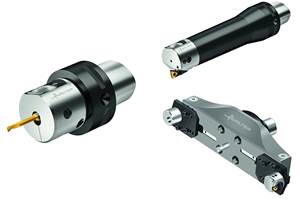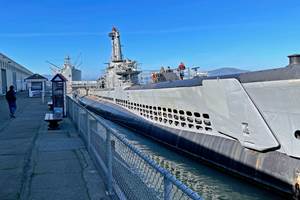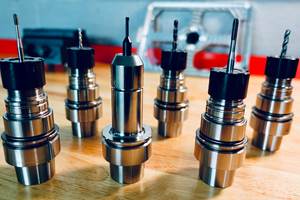Fixtures Improve Machine Performance, Product Quality And Throughput
This company previously purchased end caps and cylinder rod guides as outside components, but recently turned to Yamazen, Inc. and its line of Brother CNC tapping centers for improvement in the overall production and quality control and for a flexible manufacturing protocol on these parts.
End caps and cylinder rod guides are produced by the hundreds at Bimba Manufacturing (Monee, Illinois), a long-time leader in cylinders for various power transmission applications.
Bimba previously purchased end caps and cylinder rod guides as outside components, but recently turned to Yamazen, Inc. (Schaumburg, Illinois) and its line of Brother CNC tapping centers for improvement in the overall production and quality control and for a flexible manufacturing protocol on these parts.
Yamazen, in turn, partnered with CD Miller (Spring Grove, Illinois), which engineered and manufactured pairs of fixtures in various bore sizes to enhance the operator efficiency and the productivity of the tapping centers.
The components produced on the tapping centers included 16 part numbers, comprising front and back caps, in cast and extruded aluminum, of 3/4-inch,
1 1/16-inch, 1 1/2-inch and 2-inch bore sizes. Production run requirements up to 900 pieces were typical. In response to the JIT strategies at Bimba, plus the 14-tool position ATC on the tapping center and its less-than-three-minute machining cycle per part, Miller faced the challenge of reducing changeover to under two minutes, thus enabling the part production to run smoothly for Bimba.
The answer, in this case, was a pair of self-contained hydraulic fixtures. The left-side fixture would be stationary, while the right-side fixture would be mounted to a Yuasa rotary indexer. Thus, all sides, front and back, would be faced, drilled, chamfered, reamed, threaded and/or bored with minimal handling by the operator.
One fixture held the blank in position for OP10, where three sides were drilled and milled, while the other fixture held the semi-finished part for OP20, the back side machining functions.
In contrast to hydraulic fixtures of the past, with fittings and hydraulic tubing where chips would hang up and often cause leakage due to exposed connection points, CD Miller designed a manifold-mounted, gundrilled plate assembly. Thus, no fittings and no hydraulic tubing were present in the machining area. CD Miller also designed and supplied the entire hydraulic manifold, comprising pump, solenoid, pressure sensors, clamping controls and interface to the machine controller M-codes.
The fixtures were designed using Pro/Engineer, a 3D solid modeling package, and all critical machining conditions were simulated through CD Miller's use of COSMOS, a finite element analysis software package. FEA assured no deformation on the aluminum parts and no collapsing of the bore. Bimba supplied drawings of both the cast and extruded parts to CD Miller as the design process began. "The entire job turned around in less than ten weeks, with no rework on any of the fixtures," according to CD Miller President Chuck Miller.
The fixtures themselves were carbon steel, with A2 tool steel roller bearings, hardened bushings and 316 stainless steel quick disconnects. All steel was black oxided, and all aluminum parts were anodized. Integral stops were designed into the fixtures for easier positioning.
A key facet of the fixture design and FEA process are machine tool modelings. The entire process is designed in 3D with the work cell setup, fixture weights, centers of gravity and the clamping force on the workpiece calculated by the software. Such FEA protocols allow complex throughput calculations to be made. The result of this overall fixture-to-machining center simulation process has been a substantial reduction in time-to-market for Bimba, according to the company; approximately half the cycle time is now required. In addition there are savings realized in workpiece handling.
Related Content
Walter Extends Line of Precision Boring Tools
The new boring tools employ modular components such as cartridge holders and extensions, which are matched to the system, utilize an extensive range of indexable inserts suited for precision boring and can be used for all material groups.
Read MoreTungaloy Expands Drill System With Drill Sleeves
Adding drill sleeves to the standard lineup enhances drilling productivity of Swiss-type sliding-head automatic lathes.
Read MoreNew Machining Technology Works With Old to Restore WWII Submarine
A set of donated boring bars that can be used in a 1954 boring head will enable volunteer machinists to recreate a pair of binoculars for the USS Pampanito.
Read MoreHow Lowering Torque Improves Tapping Tool Life
Escaping the tap breakage trap requires a long look at torque and the many factors that influence it.
Read MoreRead Next
3 Mistakes That Cause CNC Programs to Fail
Despite enhancements to manufacturing technology, there are still issues today that can cause programs to fail. These failures can cause lost time, scrapped parts, damaged machines and even injured operators.
Read MoreThe Cut Scene: The Finer Details of Large-Format Machining
Small details and features can have an outsized impact on large parts, such as Barbco’s collapsible utility drill head.
Read More








.png;maxWidth=300;quality=90)
















